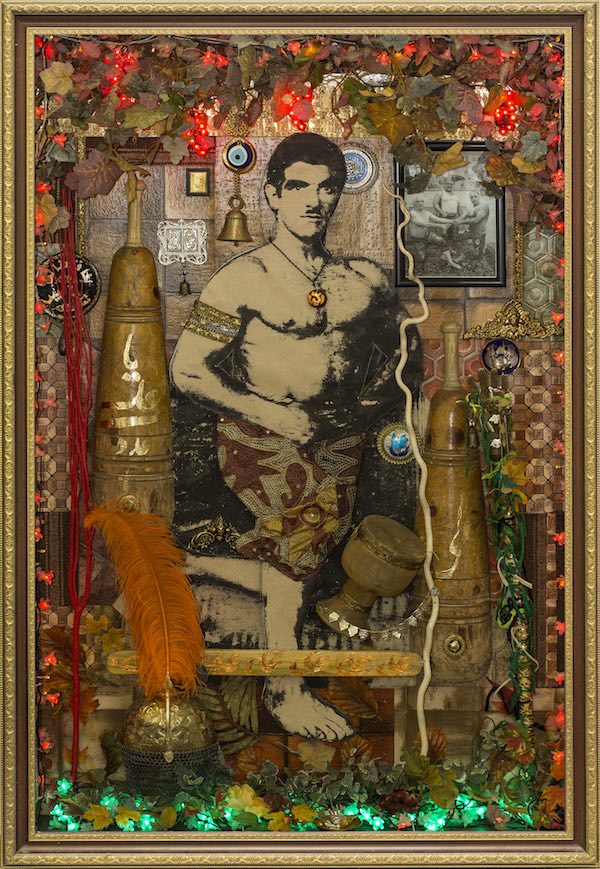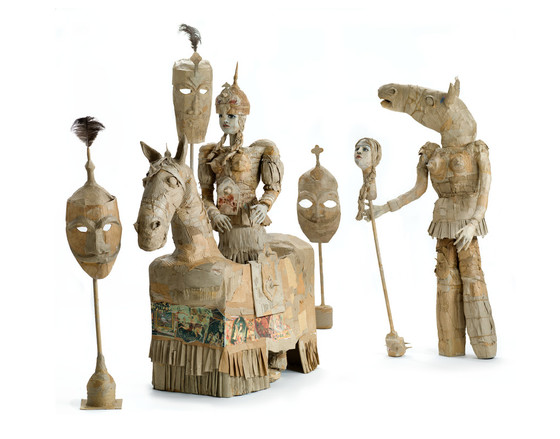These works of art will be featured in the LACMA-organized international loan exhibition In the Fields of Empty Days: The Intersection of Past and Present in Iranian Art planned for Spring 2018. This timely exhibition takes as its theme the continuous and inescapable presence of the past in Iranian society, a notion that reveals itself in art and literature in which long-ago kings and heroes are used in later context as paradigms of virtue or as objects of derision.

Shirin Neshat is perhaps the best-known Iranian artist living in diaspora. Although she left home as a teenager to study in the United States, Iran and its history, culture, and politics have played a pivotal role in her art. In the 2012 photographic series The Book of Kings, Neshat returned to the format of inscribing directly on the print, which she had used in her groundbreaking Women of Allahseries over two decades earlier (Speechless from this series was acquired through the 2012 Collectors Committee). In these more recent photographs, the text is derived from the Shahnameh or Book of Kings, the Iranian national epic, which tells of ancient kings and heroes, most of whom strive for the good of their homeland. The inherent nationalism of the text is something Neshat brings forward to the present using portraits of friends and acquaintances with their hands crossed diagonally over their hearts to depict patriots and a smaller group of villains represented by full-length male portraits with battle scenes from the Shahnameh covering their bare upper torsos like tattoos. Neshat has said that this series was inspired by political events in Iran and elsewhere in the Middle East, including the Arab Spring.

A former fruit seller and veteran of the Iran-Iraq war, Khosrow Hassanzadeh is today one of Iran's foremost contemporary artists, although he maintains a studio in the same conservative and run-down southern Tehran neighborhood where he grew up. He works mainly in silkscreen, painting and mixed media, in which he frequently juxtaposes historical and contemporary images, as here. This mixed media box, one of several such unique productions by the artist, each of which focuses on a heroic figure, provides a contemporary outlook on Iranian history, religion and culture. At the heart of this animated and flamboyant work is an image of a pahlavan—a hero or champion of high moral character. Based on a vintage photograph, this pahlavan is clothed as a member of the zurkhaneh, a traditional system of athletics originally used to train warriors in Iran, which combines martial arts, calisthenics, and strength training, with music and religious chanting. Hassanzadeh encloses the image of the pahlavan, along with actual objects of the type associated with the zurkhaneh, in a shrine-like structure, decorated with internal lights, perhaps to emulate the hijleh, an Iranian tradition of erecting temporary memorials to commemorate the dead.

Yasmin Sinai is a sculptor, who works primarily in paper and cardboard, as in these dramatic figures, which form part of a still larger installation piece. Here, Sinai interprets the mythological story of a great woman warrior—Gordafarid—for a contemporary audience in part as a reminder of the significant role women have played and continue to play in Iran. Gordafarid, the daughter of a petty ruler whose fortress guards the border between Iran and Turan, is one of just a few heroines in the Shahnameh or Book of Kings; she is the only woman warrior. When her father’s chief champion is captured by the invading Turanian army, Gordafarid dons armor and rides out to challenge the enemy’s leader, the hero Sohrab. While she does not defeat Sohrab in single combat, her bravery delays the invasion of Iran. She also plays a key role in presaging the greatest tragedy of the Shahnameh—the death of Sohrab at the hands of his father, Rostam: from the safety of her father’s fortress, she taunts the now-smitten Sohrab by predicting his downfall. The two faces of Gordafarid—the puppet head and the mounted warrior—are self-portraits of the artist.
During our 31st annual Collectors Committee Weekend (April 21–22), members of LACMA's Collectors Committee generously helped the museum acquire nine works of art spanning a breadth of eras and cultures.



